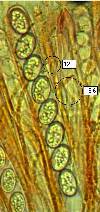Ascomycetes (Cup and Flask Fungi) Gallery
The Ascomycotina (usually referred to as ascomycetes) comprises a great many and tremendously varied forms of fungi.
Ascomycete fungi are characterised by the structures known as asci (singular ascus) inside which the spores develop.
 As an example, asci of the Eyelash Fungus Scutellinia scutellata is shown on the left. Most ascomycetes produce eight spores in each ascus, but some produce many more, Many are so small that it
is impossible to study them without a microscope, and so in this Guide attention is focused only on the larger
forms, most of which come within the
orders Pezizales, Helotiales and Sphaeriales.
As an example, asci of the Eyelash Fungus Scutellinia scutellata is shown on the left. Most ascomycetes produce eight spores in each ascus, but some produce many more, Many are so small that it
is impossible to study them without a microscope, and so in this Guide attention is focused only on the larger
forms, most of which come within the
orders Pezizales, Helotiales and Sphaeriales.
The ascomycetes - the cup fungi and flask fungi - is the largest fungal - Class of all, containing 230 families and more than 3000 genera. Over 400,000 species are known to exist, but the unknown part of this - Class of the fungal kingdom could be much greater.
Of particular interest is the order Pezizales, which includes the morels (Morchella esculenta is a fairly common species), which are greatly prized as edible mushrooms but must always be cooked before eating, and their deadly imposters the False Morels (Gyromitra esculenta).
Pezizales

These are mainly cup fungi with the spore-bearing surface (the hymenium) on the inside of the cup, although with Morchella esculenta and its relatives, the various morels, the cap is in effect an inside out compound head bearing several dozen cups crowded together and perched upon a shared stem. There are some 350 European species in this order. The example shown here is Aleuria aurantia, Orange Peel Fungus.
Helotiales

In this group of ascomycetous fungi there are mainly very small, disc-like or goblet-like fungi; however, two of the larger species, Bulgaria inquinans and Chlorociboria aeruginascens, are quite frequently encountered. More than 100 European species from this order are currently known. The example shown here is Chlorociboria aeruginascens, commonly known as the Green Elfcup.
Sphaeriales

This large 'super-order', with some 750 European species identified, is very varied in size, shape and colour. Typically the tiny fruitbodies are spherical, hemispherical, or flask-shaped, comprising carbonaceous perithecia which are embedded in the surface of a larger structure called a stroma.This group includes several orders including the Xylariales. The example shown here is Xylaria polymorpha, Dead Man's Fingers.
For more information about the Ascomycota (ascomycete fungi) and a deeper insight into the ecology and structure of the species featured in our Ascomycetes Gallery pages, please see Pat O'Reilly's latest book Fascinated by Fungi.
Fascinated by Fungi. Back by popular demand, Pat O'Reilly's best-selling 450-page hardback book is available now. The latest second edition was republished with a sparkling new cover design in September 2022 by Coch-y-Bonddu Books. Full details and copies are available from the publisher's online bookshop...






































































